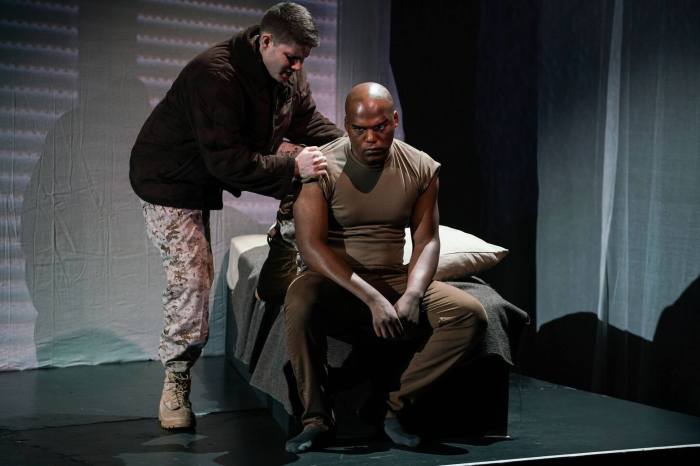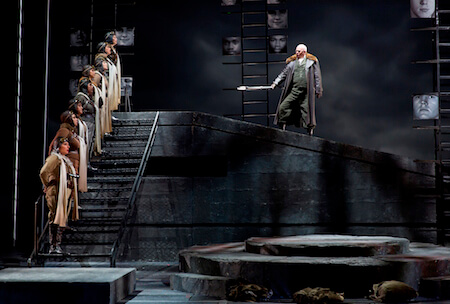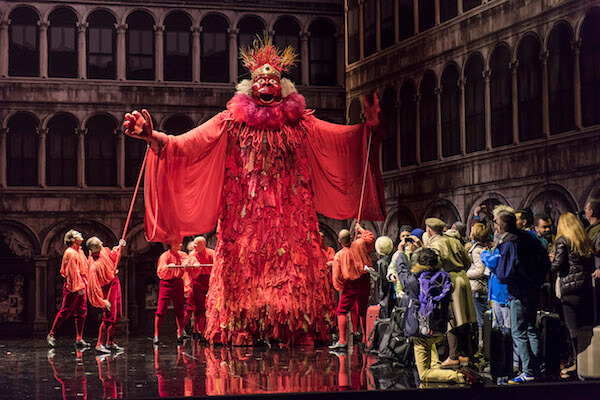Vittorio Grigolo in Massenet’s “Manon” at the Met. | KEN HOWARD/ METROPOLITAN OPERA
French opera has become something of a stepchild in the international operatic repertoire — it doesn’t always get the love and attention it needs even in Paris. Its specialists are few and far between, and the French style has become internationalized, losing character, delicacy, and perfume. The Metropolitan Opera, historically a major purveyor of the internationalized French style, presents two major French operas this month.
Massenet’s “Manon” is like “La Traviata” and “Madama Butterfly” in that the title heroine is in nearly every scene and carries the entire evening. If the soprano fails to convince, the opera fails as well. However, unlike the Verdi and Puccini operas, “Manon” also has a tour de force tenor role. On the March 9 opening night of the Met’s first revival of Laurent Pelly’s 2012 production, Vittorio Grigolo did his best work to date in New York, easily taking the show.
As the titular courtesan, Diana Damrau works very hard — too hard in fact, and the effort shows. She fills out every moment with specific detail and maintains a high level of energy (too high as the teenaged Act I Manon — she came off like a hyperactive hoydenish tomboy). Damrau’s sung and spoken French pronunciation is more than respectable (her husband Nicolas Testé is French). Her voice has darkened and lowered; I found her middle register husky and labored, and her easy top notes have hardened. The legato passages lack beguiling spin and float, with a reliance on declamatory phrasing. When Damrau took her foot off the gas pedal, a more youthful appealing sound emerged.
“Manon,” “Les Contes d’Hoffmann” take bows at the Met
Her presentational acting is all surface — never once did she seem to relax into the character and she had all the fatal allure of a soccer mom. Striking supermodel poses does not automatically make one sexy. Damrau is a fine serious artist but she is profoundly miscast as Abbé Prevost’s anti-heroine.
A generous performer and gifted actor, Grigolo is a perfect match for the reckless, impressionable, emotionally self-destructive Des Grieux. The Italian tenor always seems impulsive on stage — hotheaded and driven by instinct and emotion. Grigolo’s over-the-top moments, unlike Damrau’s, arise from his own Latin temperament and intense personal investment in the character and situation. His lean, bright tenor blossoms on high, making it perfectly suited to the French idiom. In the Act II dream aria “En fermant les yeux,” Grigolo sustained an intense mezza voce with subtle gradations of tone and verbal expression. He climaxed the final death scene by throwing himself over Manon’s body, emitting a howl of grief like a wounded animal. The moment was not melodramatic but rather cathartic.
Canadian baritone Russell Braun was vocally solid but visually stolid as the rascally Lescaut. Christophe Mortagne was a droll scene-stealing delight as Guillot, and Dwayne Croft, despite some vocal dryness, a persuasive de Brétigny. Nicolas Testé as the Comte des Grieux performed with insight and style despite an unimposing, soft-edged bass-baritone. Emmanuel Villaume’s conducting achieved big-scaled lyrical scope at the expense of incisive detail.
This season the Met has presented two casts in Offenbach’s “Les Contes d’Hoffmann.” The starrier first cast, headlined by Vittorio Grigolo and Thomas Hampson, was transmitted in HD in late January. However, the second cast led by James Levine was in every way more convincing and stylish.
Grigolo’s Hoffmann was erratic vocally and dramatically — he sang loudly when he should have been using voix mixte and crooned when power was called for. His Hoffmann remained the same hotheaded Latin lover throughout — even as the drunken wreck in Luther’s tavern. Hampson refused to alter his customary ramrod posture, pompous air of self-regard, and sculpted coif as the Four Villains. His baritone sounded gray and dried out and disappeared entirely in the lower regions of this bass role. The best of the ladies was Erin Morley as Olympia — a crystalline, exact coloratura soprano used with charm. Hibla Gerzmava’s Antonia was richly sung with a sturdy lyric bordering on spinto soprano. However, Gerzmava is a stiff dull actress and lacked fragility as the doomed maiden. Christine Rice sang solidly and pleasantly as Giulietta but lacked vocal and visual seductiveness — probably she’s a natural Nicklausse. Kate Lindsey exuded enigmatic mystery and androgynous allure as both Nicklausse and the Muse but her slender resiny mezzo-soprano was one size too small in the house. Bart Sher’s busy, dark-toned production threw a wet blanket over the efforts of everyone involved, including a vivacious Yves Abel in the pit.
On March 11, Matthew Polenzani’s Hoffmann had all the musical polish, vocal discipline, and dramatic focus that Grigolo lacked. His bright plangent tenor cannily maneuvered the huge Met auditorium. Laurent Naouri was surprisingly vocally puissant as the Four Villains, with native diction, a wide vocal range, and four vibrant characterizations full of droll wit and macabre panache. Karine Deshayes, another native French artist, has a medium-size mezzo with soprano brightness on high and scored in Niklausse's arias. Audrey Luna’s Olympia was a dead ringer for the young Carol Burnett, and her excursions above high C (up to the A flat above) had an unearthly ease. Within the normal soprano scale, Luna’s thin tone turns sour and unpleasant, but she is a force onstage. Susanna Phillips’s fresh, appealing soprano and girlish vulnerability promised a perfect Antonia, but sadly her soprano tired during the final trio and the climactic D flat was a whimper. Elena Maximova was a visually and vocally voluptuous Giulietta who dominated the stage. Levine clearly loves this score and his reading was rich in detail and sweeping in musical command.



































